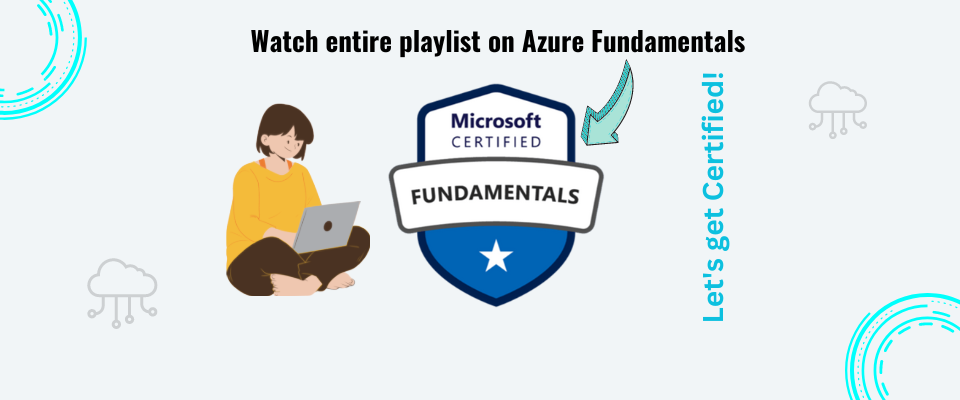Azure - Exam
AZ-900: Azure Fundamentals - Guide
Azure Fundamentals (AZ-900)
This certification (AZ-900) is designed for candidates who want to demonstrate basic knowledge of cloud services and how these services are provided using Microsoft Azure. This certification is a common starting point in a journey towards a career in Azure.
Here is Microsoft official documentation: Exam AZ-900: Microsoft Azure Fundamentals
Important: The English language version of this exam is updated on July 31, 2023. Click here (video) to understand.
The AZ-900 exam is a Microsoft certification exam called "Microsoft Azure Fundamentals." It is designed to validate foundational knowledge and understanding of cloud concepts, Azure services, security, privacy, compliance, and pricing. The AZ-900 exam is intended for individuals who are new to the Azure cloud platform and want to demonstrate their basic understanding of Azure and cloud computing. It is suitable for a wide range of roles, including:
- Business Decision Makers
- IT Professionals
- Students and Educators
- Sales and Marketing Teams
- Anyone interested in Azure
Skills measured
- Describe cloud concepts (25–30%)
- Describe Azure architecture and services (35–40%)
- Describe Azure management and governance (30–35%)
Describe cloud concepts (25–30%)
- Describe cloud computing
- Define cloud computing
- Describe the shared responsibility model
- Define cloud models, including public, private, and hybrid
- Identify appropriate use cases for each cloud model
- Describe the consumption-based model
- Compare cloud pricing models
- Describe serverless
- Describe the benefits of using cloud services
- Describe the benefits of high availability and scalability in the cloud
- Describe the benefits of reliability and predictability in the cloud
- Describe the benefits of security and governance in the cloud
- Describe the benefits of manageability in the cloud
- Describe cloud service types
- Describe infrastructure as a service (IaaS)
- Describe platform as a service (PaaS)
- Describe software as a service (SaaS)
- Identify appropriate use cases for each cloud service (IaaS, PaaS, SaaS)
Describe Azure architecture and services (35–40%)
- Describe the core architectural components of Azure
- Describe Azure regions, region pairs, and sovereign regions
- Describe availability zones
- Describe Azure datacenters
- Describe Azure resources and resource groups
- Describe subscriptions
- Describe management groups
- Describe the hierarchy of resource groups, subscriptions, and management groups
- Describe Azure compute and networking services
- Compare compute types, including container instances, virtual machines (VMs), and functions
- Describe VM options, including Azure Virtual Machines, Azure Virtual Machine Scale Sets, availability sets, and Azure Virtual Desktop
- Describe resources required for virtual machines
- Describe application hosting options, including web apps, containers, and virtual machines
- Describe application hosting options, including the Web Apps feature of Azure App Service, containers, and virtual machines
- Describe virtual networking, including the purpose of Azure Virtual Networks, Azure virtual subnets, peering, Azure DNS, Azure VPN Gateway, and Azure ExpressRoute
- Define public and private endpoints
- Describe Azure storage services
- Compare Azure storage services
- Describe storage tiers
- Describe redundancy options
- Describe storage account options and storage types
- Identify options for moving files, including AzCopy, Azure Storage Explorer, and Azure File Sync
- Describe migration options, including Azure Migrate and Azure Data Box
- Describe Azure identity, access, and security
- Describe directory services in Azure, including Microsoft Azure Active Directory (Azure AD), part of Microsoft Entra and Azure Active Directory Domain Services (Azure AD DS)
- Describe authentication methods in Azure, including single sign-on (SSO), multi-factor authentication (MFA), and passwordless
- Describe external identities in Azure, including business-to-business (B2B) and business-to-customer (B2C)
- Describe Conditional Access in Azure AD
- Describe Azure role-based access control (RBAC)
- Describe the concept of Zero Trust
- Describe the purpose of the defense in depth model
- Describe the purpose of Microsoft Defender for Cloud
Describe Azure management and governance (30–35%)
- Describe cost management in Azure
- Describe factors that can affect costs in Azure
- Compare the Pricing calculator and the Total Cost of Ownership (TCO) calculator
- Describe cost management capabilities in Azure
- Describe the purpose of tags
- Describe features and tools in Azure for governance and compliance
- Describe the purpose of Microsoft Purview in Azure
- Describe the purpose of Azure Policy
- Describe the purpose of resource locks
- Describe features and tools for managing and deploying Azure resources
- Describe the Azure portal
- Describe Azure Cloud Shell, including Azure Command-Line Interface (CLI) and Azure PowerShell
- Describe the purpose of Azure Arc
- Describe infrastructure as code (IaC)
- Describe Azure Resource Manager (ARM) and ARM templates
- Describe monitoring tools in Azure
- Describe the purpose of Azure Advisor
- Describe Azure Service Health
- Describe Azure Monitor, including Log Analytics, Azure Monitor alerts, and Application Insights






